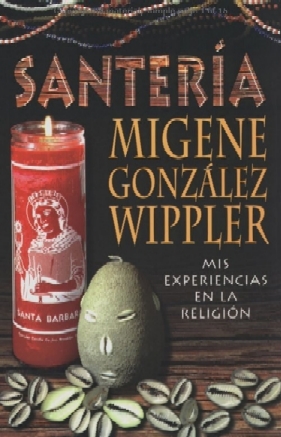|
Rotten Library > Religion > Santeria
Santeria From medieval times on, colonial white cultures spread out over the world to share the many advancements of Western civilization with the unenlightened masses, advancements like kidnapping, whippings, rape, murder, genocide, beatings, smallpox, slavery, monogamy and Christianity.
From medieval times on, colonial white cultures spread out over the world to share the many advancements of Western civilization with the unenlightened masses, advancements like kidnapping, whippings, rape, murder, genocide, beatings, smallpox, slavery, monogamy and Christianity.What philanthropists! Of course, not everyone took to Christianity. For one thing, there was the pesky fact that it was often attached to the smallpox, rape, whippings and slavery. This did not endear Christians to many native Africans, who were so often on the receiving end of these advancements. The French, Spanish and Portugese were especially strident about inflicting Jesus-style salvation on their newfound work force, forcibly baptizing many slaves seized from West Africa into the Roman Catholic church, before transporting them to their new, happiness-free lives in the Carribean and South America. In North America, slaves often adopted Christianity as comfort and source of strength against their plight. In French colonies, survivals of the original African religions mutated into Voudoun, more popularly known as voodoo. In South America and the Carribean, a strange hybrid emerged. The captured slaves nominally accepted the Catholicism that had been forced on them, but it melted into remnants of West African religions and became something new, a practice known as Regla de Ocha. Spanish slavemasters derisively referred to the new religion as Santeria, or "Way of the Saints," a name which stuck. Theologically, Santeria was a pretty straight-up hybrid between African religion and Roman Catholicism. Adherents viewed the Christian saints as avatars of the Orisha, a pantheon of lesser deities, while the Christian figure of God was seen as Olodumare, the African creator-god who rules over all of the others.
Thus, Shango, the god of fire and wrath, became St. Barbara, a martyr whose death at the hands of her father was avenged when God set the perpetrator ablaze. Babaluaiye, the Orisha of health, became St. Lazarus, the man whom Christ famously raised from the dead. The treatment of saints in Santeria was fetishistic to the extreme. Saintly icons were seen as objects of great power, and they are often displayed in ornate and lavish altar settings which are either garish or gorgeous, depending on your taste. In addition to the over-the-top veneration of saints, a number of other elements really began to creep out those who didn't take part in the religion. Despite its outer homage to Christianity, the practices of Santeria were much different. Priests and priestesses, known as Santeros and Santeras, led the community in highly secretive rituals, of which little is known to outsiders, even today. What is known is that these practices include blood sacrifices of animals, ritual possession (similar to that practiced in Voudoun) and the use of magic potions and charms made from herbs and stones associated with various Orisha and other deities. These known elements led to much speculation about what the secretiveness was all about, and soon gave birth to never-proven rumors about human sacrifice, Satanism, devil worship and witchcraft. Although the infrastructure of slavery collapsed in the 19th century, Santeria continued and spread geographically to establish small outposts in various parts of the world, including Mexico (where it caught on in a big way) and North America (where it caught on in a very small way). While other religions and occult traditions such as Freemasonry, witchcraft and voudoun worked to educate outsiders about their generally good intentions, adherents of Santeria stuck with what had worked for them — strict secrecy. When it became politically incorrect to accuse Wiccans of frolicking in the woods with the Dark Man, Christian fundamentalists and the intellectual underachievers of middle America were in a virtual panic to find a suitably villainous movement of Satan lovers. You can guess where this is going. In 1989, the anti-Santeria frenzy reached its peak with a gruesome mass murder in Matamoros, Mexico. Thirteen people were found mutilated and killed by various unpleasant means, including boiling in oil, at a ranch near the town of Matamoros. Mass quantities of drugs were also found on the scene.
Martin Sheen inexplicably went on to become a liberal icon, despite this movie, which helped give bottom-feeding scum like Jerry Falwell and Pat Robertson enough false material to last them well into the 21st century. Although Santeria has recently taken on a certain amount of the New Age chic according to Witchcraft and The Occult in the last 50 years, it still remains on the far fringe of religious practice. If you're looking for a load of baseless happy crap to offset the load of baseless nasty crap spread by Sheen and Falwell, you can find Santeria enthusiasts aplenty among the voluminous middle-class-white-kids-who-think-they-have-problems caste of American society. They'll give you a right proper PC song and dance, but aside from long lists of baseball-card-style stats on the saints/orisha, it's highly unlikely they know meaningfully more about Santeria than you do after reading this article. Ignore them, but be tactful. Middle-class-white-kids-who-think-they-have-problems can be dangerous when cornered by superior knowledge.
|
 The Orisha and other, lesser deities were a direct outgrowth of earlier animistic religions, with each performing a specific function in the grand scheme of the universe. They could be petitioned to help out adherents whose problems were related to these vocational specialties. Since the first practitioners of Santeria were required — on pain of death — to practice Catholicism, they paid tribute to the Orisha in their "saintly" forms.
The Orisha and other, lesser deities were a direct outgrowth of earlier animistic religions, with each performing a specific function in the grand scheme of the universe. They could be petitioned to help out adherents whose problems were related to these vocational specialties. Since the first practitioners of Santeria were required — on pain of death — to practice Catholicism, they paid tribute to the Orisha in their "saintly" forms.  The sensational nature of the murders immediately led the media to groundless speculation that the murders were somehow Satanically inspired. In fact, they were drug-dealing inspired, although the drug-gang's leader practiced a weird mish-mash of religious hoodoo, including elements of Santeria. Among his non-standard practices: He required gang members to repeatedly view "The Believers," an incredibly bad horror movie in which Martin Sheen encounters a cult of grisly-human-sacrificing bad guys. The bad guys are characterized as Santerians, but the movie barely distinguishes between its stupid misconceptions about Santeria and its stupid misconceptions about voodoo.
The sensational nature of the murders immediately led the media to groundless speculation that the murders were somehow Satanically inspired. In fact, they were drug-dealing inspired, although the drug-gang's leader practiced a weird mish-mash of religious hoodoo, including elements of Santeria. Among his non-standard practices: He required gang members to repeatedly view "The Believers," an incredibly bad horror movie in which Martin Sheen encounters a cult of grisly-human-sacrificing bad guys. The bad guys are characterized as Santerians, but the movie barely distinguishes between its stupid misconceptions about Santeria and its stupid misconceptions about voodoo.